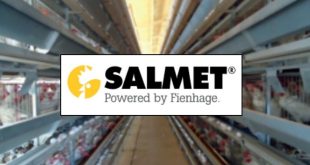Amandine Cabot, Audrey Sacy, Lallemand Animal Nutrition (France) : In a context of antibiotic reduction in feed, there is a need for natural, profitable and proven solutions for poultry production. Probiotic bacteria which exert a positive effect on the digestive microflora balance and gut development can help improve laying performance. The lactic acid bacteria Pediococcus acidilactici MA 18/5M, producing a high level of lactic acid, is one of the most studied probiotic bacteria with more than 40 scientific publications in monogastric feeding. Its modes of action are well-documented. This is confirmed by results obtained in farms and trials in commercial settings which consistently show benefits on laying performance, in particular through an improved laying rate, resulting from better feed conversion. In addition, probiotic benefits lead to improved poultry survival and egg quality, representing significant benefits for producers.
Probiotics are specific beneficial bacteria selected for their benefits in the host diet. The lactic acid producing bacteria P. acidilactici MA 18/5M is a well described probiotic strain*. It has the ability to produce important amounts of lactic acid in the gut of monogastric animals, and L+ lactic acid only (homofermentative bacteria). Its ability to survive the poultry digestive tract and remain alive for few days in feces has also been demonstrated. Its effects are translated into three major consequences for the animal: 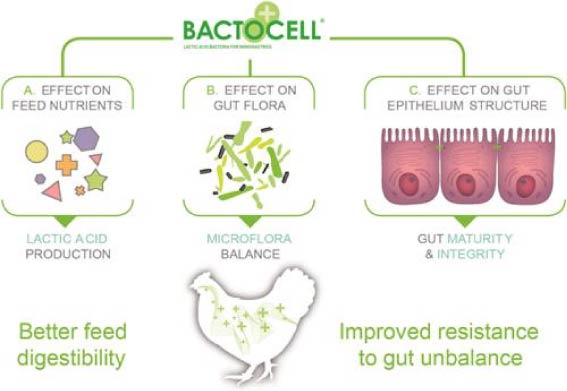
- Enhanced feed digestibility. P. acidilactici MA 18/5M produces important amounts of lactic acid from complex sugars present in the feed. This contributes to improve feed digestibility and increase feed efficiency: 1) because lactic acid is highly digestible (source of energy) and 2) because more sugar (a factor of viscosity) is transformed into lactic acid, viscosity of the feed is lower, facilitating enzyme access to break-down feed particles.
- Improved gut microflora balance. Because P. acidilactici MA 18/5M produces lactic acid in the gut, it causes a local decrease of pH close to the gut surface (villi) creating a favorable environment for the development of beneficial bacteria and unfavorable for potential pathogenic bacteria such as coliforms, salmonella… The lactic bacteria compete with pathogens for nutrients, helping to keep them under control.
- Enhanced gut maturity. P. acidilactici MA 18/5M supplementation increases the height of gut villi, thus increasing the gut absorption surface area. As a result, nutrients are better absorbed and feed digestibility is increased.
Altogether, these modes of action contribute to explain the unique effects of P. acidilactici MA 18/5M supplementation on layers digestive function and performance.
Higher laying performance
The results of multiple trials conducted in laying hens with probiotic Pediococcus acidilactici MA 18/5M have been compiled in order to evaluate the probiotic potential benefits for farm performance. The data and results from six different trials published conducted in research institutes and in commercial farms, with different housing systems, genetics, and various supplementation duration, were analysed.

Depending on the trials, laying rate is increased by 2 to 3.4%, while egg weight is also always increased (up to 2.8%), resulting in consistant increase of exported egg mass (from 0.6% for the shortest trial duration, up to 5%) (Figure 1).
Statistical analysis were performed on the results of four trials on a 24-week duration (from week 22 to 46): in average P. acidilactici MA 18/5M significantly increased the laying rate by 2.8% (p<0.05) and exported egg mass by 3.5% (p<0.01), equivalent to an extra 13.1g of egg/hen/week, or 131 Kg/ week for 10,000 hens.
This effect is linked to improved feed utilization with the probiotic, as shown by improved feed conversion rate (Figure 2). Similar statistical analysis indicate a reduced feed conversion rate equivalent to -0.07kg/kg.
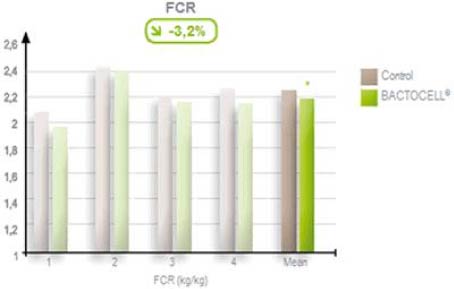
In addition, trials typically show a positive effect on the laying curve: it is sustained and smoothen over the whole cycle. P. acidilactici MA 18/5M, supplemented during the whole cycle, improves laying persistence (Figure 3)
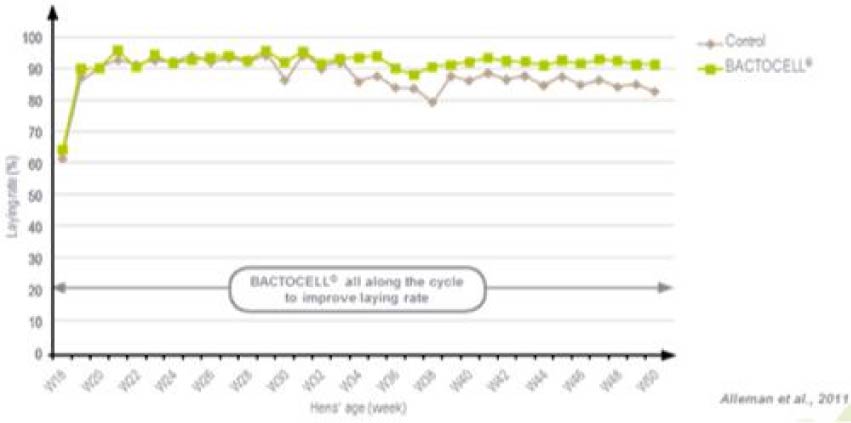
Reducing mortality
Several trials have shown that, under challenged conditions and high pathogens pressure, the lactic acid bacteria, thanks to its positive effect on the digestive microflora, helps control pathogens development and reduces mortality risks due to bacterial challenge.
This has been observed in many farm conditions. A production trial conducted in Morocco in 2011/2012 confirms this effect in commercial farming conditions (Figure 4).
In this trial, at the end of the laying period (71 weeks), the cumulative mortality was 4.08% in the treated building vs. 4.92% in the control building; equivalent to 481 hens spared during the trial period.
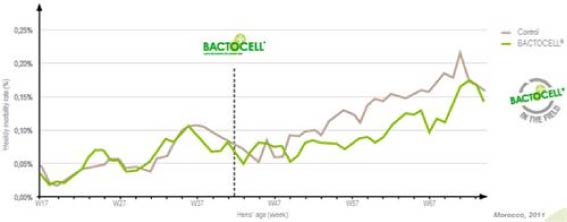
In 2015 a French commercial trial gathering about 200.000 ISABROWN laying hens also showed a concomitant mortality reduction in two buildings independently receiving P. acidilactici MA 18/5M. In the first building (72.000 laying hens), the hens were supplemented from 17-60 weeks of age, with a four weeks discontinuation (week 34-38). Following this disruption of the supplement, the mortality increased 2.5-fold (weekly mortality: 22 hens before vs. 56 after the probiotic disruption). In the same manner, after the end of the supplementation period (week 60), the mortality increased 2.9-fold (weekly mortality: 161 after the supplementation).
In a second building (119.000 laying hens), P. acidilactici MA 18/5M implementation followed a spur of mortality linked to colibacillosis outbreak at week 36 of age. The supplementation (from week 37 to helped control the mortality; while, from week 54, when the supplementation stopped, weekly mortality rose again (weekly mortality 220 vs. 116).
Benefits had moreover been observed in Asian commercial farms carrying out forced molting.
Reductions by half of the mean daily mortality have been reported (1.52 % vs. 0.805%).
This benefit is linked to P. acidilactici MA 18/5M effects on the control of pathogens development, in the gut and consequently on the barn environment and the egg surface. Studies have shown that P. acidilactici MA 18/5M shifts gut microflora toward a more balanced profile under challenging conditions: reduced Clostridium perfringens., Salmonella typhimurium., Salmonella enteriditis, Escherichia coli.
Effect on fecal microflora
In a laying farm, feces represent a major pathogen reservoir, source of cross-contamination, and a potential vector of food-borne pathogen transmission through the litter or dusts in the environment. It has been shown that the microbiological analysis of fecal microflora can thus be a good indicator of a farm sanitary risk status The ratio between beneficial microflora (lactobacilli, or lactic acid producing bacteria), and potential pathogenic microflora can be used as an indicator of both the animal digestive microflora balance and the farm sanitary status. Such fecal microflora analysis has been established by Lallemand Animal Nutrition as a tool to evaluate the potential sanitary risk in farm settings and the influence of P. acidilactici MA 18/5M on the digestive ecosystems.
A field trial in an organic layer farm (2011), indicated a reduced count of potential pathogens (total coliforms, enterobacteria and E. coli) in the fecal microflora of 50-weeks old hens, as compared to an untreated control group, leading to a well balanced microflora.
These results were confirmed within various commercial farm settings and conditions through a large-scale field survey encompassing 39 commercial layer farms (in France). 22 of these farms supplemented their laying hens with P. acidilactici MA 18/5M while the 17 remaining ones did not include a probiotic in their feed. It also came out from this field survey that the hens receiving P. acidilactici MA 18/5M showed improved microflora ratio (Figure 5).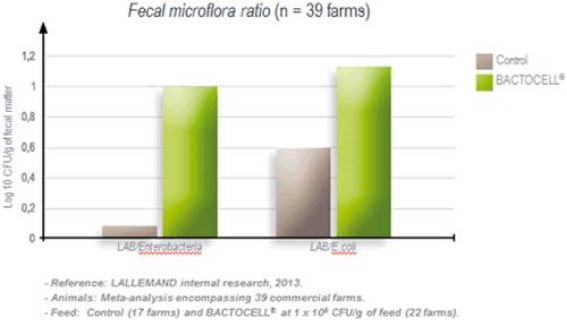
Figure 5
By helping controlling the digestive microflora, P. acidilactici MA 18/5M has positive consequences on the fecal microflora balance, which in turn help control environmental contamination by pathogens (the barn, air dust), as shown in the field surveys, creating a “virtuous cycle”. A lower pathogen load in the feces in the barn is an interesting outcome in itself since it reduces the risks of cross-contaminations and sanitary risks for the consumer (egg contamination for example).
In a context of increasing market pressure for antibiotic reduction in poultry farming and high feed costs, acceptable, scientifically-proven solutions to enhance feed conversion rate and layer performance are necessary. Lactic acid bacteria probiotic appears as an effective and sustainable solution to attain production goals and maintain poultry health and sanitary status all along the production cycle. It has beneficial influence on gut flora balance and maturity, enhancing basal digestive and gut barrier functions. Such impact at gut level came to act as an effective animal’s performance booster offering better efficiency to the egg producer. In addition, extra benefits such as better resistance to pathogens and reduced mortality, but also improved egg quality (less broken and dirty eggs, reduced meat spots, thicker eggshell…), or improved feathering have been documented, which brings additional revenue to the farmer and better animal valorization at the end of the production cycle. These benefits have been officially recognized by the European Commission who registered the probiotic bacteria as a zootechnical feed additive for laying hens in March 2011 (Regulation (EC) No 1831/2003), based on some of the trials data presented in this article.
*Not all products are available in all markets nor all claims allowed in all regions. BACTOCELL® is produced in Lallemand’s certified bacteria plants, guaranteeing products safety, quality, traceability and concentration of live bacteria. It is available in different forms: a powder destined to be mixed with mash feed, and a microencapsulated form (BACTOCELL®ME), in powder as well, designed for
pellet applications, and a soluble form for use in drinking water sytems: BACTOCELL® DRINK. It is authorized by the European Union (EFSA) as a zootechnical feed additive in laying hens and broiler, as well as by
Article made possible through the contribution of Amandine Cabot, Audrey Sacy and Lallemand Animal Nutrition (France)
 Agrinews24 কৃষির সাথে, কৃষকের পাশে
Agrinews24 কৃষির সাথে, কৃষকের পাশে



















